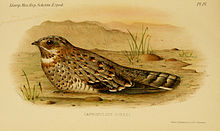| Nubian nightjar | |
|---|---|

| |
| Illustration by Henrik Grönvold of the subspecies jonesi | |
| Scientific classification | |
| Domain: | Eukaryota |
| Kingdom: | Animalia |
| Phylum: | Chordata |
| Class: | Aves |
| Clade: | Strisores |
| Order: | Caprimulgiformes |
| Family: | Caprimulgidae |
| Genus: | Caprimulgus |
| Species: | C. nubicus
|
| Binomial name | |
| Caprimulgus nubicus Lichtenstein, MHC, 1823
| |
The Nubian nightjar (Caprimulgus nubicus) is a species of nightjar in the family Caprimulgidae. It is found in salt marshes[2] of Djibouti, Egypt, Eritrea, Ethiopia, Israel, Kenya, Oman, Saudi Arabia, Somalia, Sudan, and Yemen.
Description
[edit]The Nubian nightjar is 20–22 cm (7.9–8.7 in) long. It is a nocturnal species, known for its large eyes and beak, which help it hunt at night. The bird resembles the Moorish nightjar, but is smaller, has a shorter tail and blunt wings compared to the Moorish nightjar. Another characteristic feature is a red-brown band over the neck. The white wing spots are not further away from the wing tips than other types of nightjars.[3]

Nesting
[edit]Like other nightjars, the Nubian nightjar nests on the ground. Its nests are clustered in small groups of 1 to 3.[4] It is hypothesized to prefer to nest near agricultural areas for greater access to food.[4]
References
[edit]- ^ BirdLife International (2016). "Caprimulgus nubicus". IUCN Red List of Threatened Species. 2016: e.T22689912A93252462. doi:10.2305/IUCN.UK.2016-3.RLTS.T22689912A93252462.en. Retrieved 11 November 2021.
- ^ Wainer, Howard (2023-04-03). "Three Welcome Arrivals for 2023: 1. Florence Nightingale". CHANCE. 36 (2): 45–48. doi:10.1080/09332480.2023.2203662. ISSN 0933-2480. S2CID 258378524.
- ^ Mullarny, K.; et al. (1999). ANWB Vogelgids van Europa, Tirion, Baarn. ISBN 90-18-01212-2.
- ^ a b "Caprimulgus nubicus Lichtenstein. Nubian Nightjar. Engoulevent de Nubie.", The Birds of Africa, Academic Press Limited, 1988, doi:10.5040/9781472927002.0114, ISBN 978-1-4729-2700-2, retrieved 2023-09-08
Further reading
[edit]- Kirwan, Guy M. (2004). "Some remarks on the taxonomy of Nubian Nightjar Caprimulgus nubicus, with particular reference to C. n. jonesi Ogilvie-Grant & Forbes, 1899" (PDF). Bulletin of the African Bird Club. 11 (2): 117–125. doi:10.5962/p.309720. Retrieved 20 August 2010.

Well, that’s interesting to know that Psilotum nudum are known as whisk ferns. Psilotum nudum is the commoner species of the two. While the P. flaccidum is a rare species and is found in the tropical islands. Both the species are usually epiphytic in habit and grow upon tree ferns. These species may also be terrestrial and grow in humus or in the crevices of the rocks.
View the detailed Guide of Psilotum nudum: Detailed Study Of Psilotum Nudum (Whisk Fern), Classification, Anatomy, Reproduction